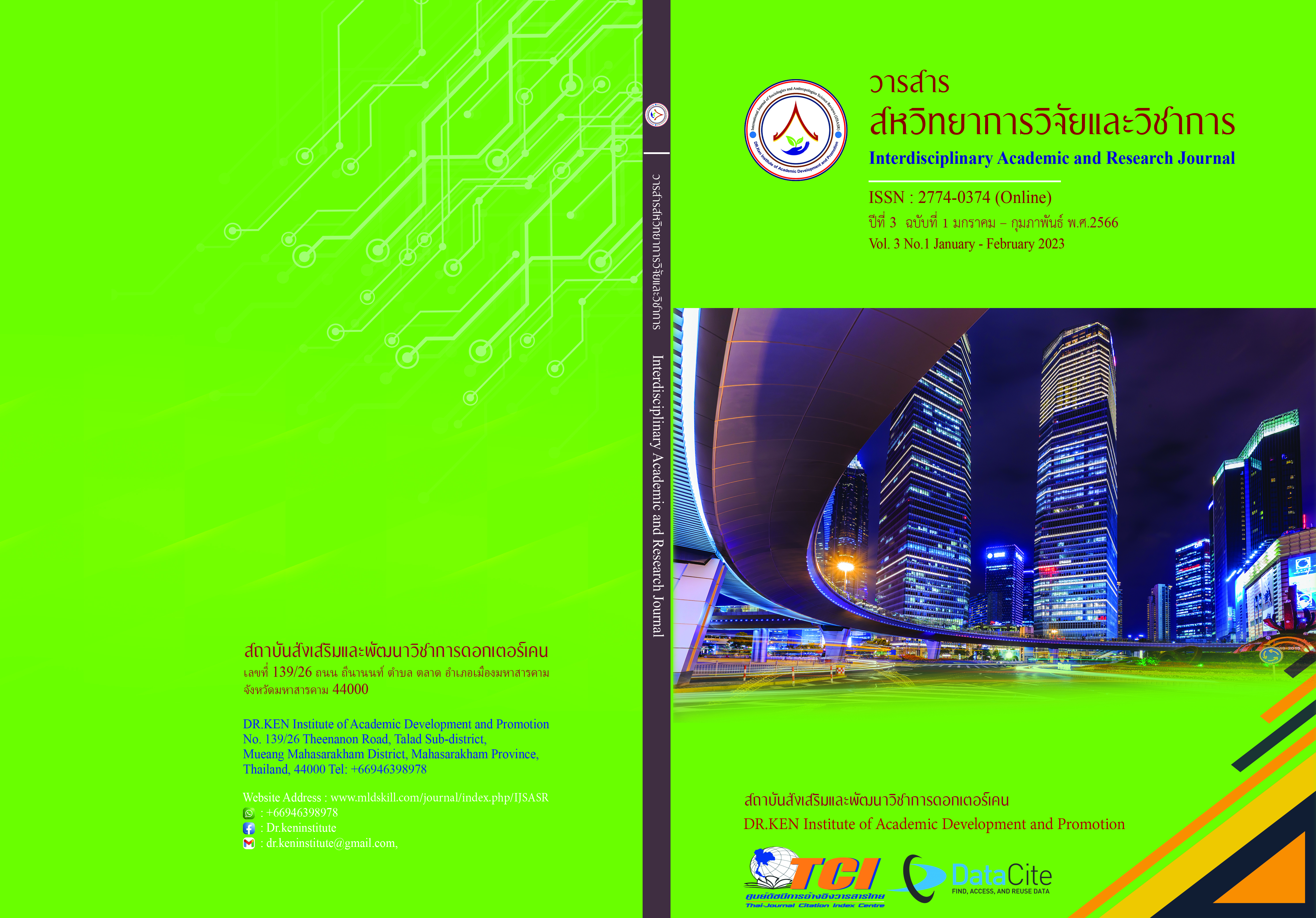Blended Problem-Based Learning Management Promoting Mathematical Problem-Solving Abilities for 6th-grade Students of Anuban Rattana Kalasin School
DOI:
https://doi.org/10.14456/iarj.2023.20Keywords:
Problem-based learning; , Blended learning; , Mathematics Problem Solving SkillAbstract
Mathematics plays a crucial role in the development of human thinking, fostering creativity, logical and systematic thinking, and the ability to thoroughly analyze problems and situations. It can be applied in daily life correctly and appropriately. According to the results of the Ordinary National Education Test, most students have lower achievement in mathematics than the standard and lack the ability to solve mathematical problems. The purpose of this research aimed to, 1) study Blended Problem Base learning management on the development of Mathematical problem-solving abilities of 6th-grade students at Anuban Rattana Kalasin school, 2) study the abilities of mathematics problem-solving by Blended Problem Based Learning, 3) study the satisfaction of students on blended problem-based learning management. The participants of this research were 38 students in 6th grade in the second semester of the 2018 educational year at Anuban Kalasin School. This research was classroom action research. The research instruments included a Blended Problem Base learning lesson plan, a Mathematical problem-solving abilities test, a satisfaction questionnaire, student journals, and a student interview guide. Data analysis of this research was 1) qualitative data analysis by analyzing data, concluding, and describing the result, and 2) quantitative data analysis using percentage, mean, and standard deviation. The research findings suggested that 1) Mathematical problem-solving abilities using blended problem base learning that included 6 stages that are Specify the problems Understand the problems Study and research Synthesize the knowledge Conclude and evaluate the result Report and evaluate the work, are the activities that encourage self-learning on students and promote student problem-solving abilities, 2) students participated in Blended Problem Base learning management have good Mathematical problem-solving abilities at the average of 4.44, and 3) the student’s overall satisfaction with the blended problem base learning activity showed the highest level at the average of 4.50s.
References
กระทรวงศึกษาธิการ. (2552). หลักสูตรแกนกลางการศึกษาขั้นพื้นฐาน พุทธศักราช 2551. กรุงเทพฯ : ชุมนุมสหกรณ์การเกษตรแห่งประเทศไทย.
กระทรวงศึกษาธิการ. (2560). หลักสูตรแกนกลางการศึกษาขั้นพื้นฐาน พุทธศักราช 2551 (ฉบับปรับปรุง 2560). กรุงเทพฯ: ชุมนุมสหกรณ์การเกษตรแห่งประเทศไทย.
จรรยา อาจหาญ. (2549). หลักสูตรและการจัดการเรียนรู้คณิตศาสตร์ประถมศึกษา. มหาสารคาม: ตักศิลาการพิมพ์.
ทัศนีย์ ธราพร, อารัมภ์ เอี่ยมลออ, เบญจวรรณ รุ่งเรืองศุภรัตน์ (2563). การเรียนรู้แบบผสมผสาน (Blended Learning) กับอนาคต การจัดการศึกษาสำหรับสังคมในแบบฐานวิถีชีวิตใหม่. Journal of Liberal Arts, RMUTT. 1 (2), 13-20.
ปณิตา วรรณพิรุณ.(2553). สื่อการเรียนการสอนบนเครือข่ายคอมพิวเตอร์. กรุงเทพฯ. ภาควิชา ครุศาสตร์เทคโนโลยี คณะครุศาสตร์อุตสาหกรรม มหาวิทยาลัยเทคโนโลยีพระจอมเกล้าพระ นครเหนือ
ยรรยง สินธุ์งาม. (2554). การเรียนรู้โดยใช้ปัญหาเป็นฐาน Problem – based Learning (PBL). Retrieved on November 11, 2011, from http://www.vcharkarn.com
วราลี สิริปิยธรรม. (2557). การพัฒนาผลสัมฤทธิ์ทางการเรียนและทักษะการคิดแก้ปัญหา ของนักเรียนชั้นมัธยมศึกษาปีที่ 6 โดยใช้การจัดการเรียนรู้แบบโครงงาน. วิทยานิพนธ์ ค.อ.ม. กรุงเทพฯ: สถาบันเทคโนโลยีพระจอมเกล้าเจ้าคุณทหาร ลาดกระบัง.
สถาบันส่งเสริมการสอนวิทยาศาสตร์และเทคโนโลยี. (2551). การจัดสาระการเรียนรู้กลุ่มสาระการเรียนรู้วิทยาศษสตร์ หลักสูตรการศึกษาขั้นพื้นฐาน. กรุงเทพฯ : โรงพิมพ์คุรุสภาลาดพร้าว.
สำนักงานเลขาธิการสภาการศึกษา.(2550). รูปแบบการจัดการเรียนรู้เพื่อพัฒนาความสามารถของเด็กในการอ่าน คิด วิเคราะห์ เขียน และสร้างองค์ความรู้ด้วยตนเอง โดยเน้นผู้เรียนเป็นสำคัญ. กรุงเทพฯ : สำนักงานเลขาธิการสภาการศึกษา.
สุธน วงค์แดง. (2565). การเรียนรู้แบบผสมผสาน (Blended Learning) ที่ส่งเสริมทักษะการเรียนรู้ภาษาอังกฤษ ในห้องเรียนระดับการศึกษาขั้นพื้นฐาน : โอกาสและความท้าทายของผู้สอนและผู้เรียน ในยุคของการเรียนรู้เพื่อการเปลี่ยนแปลง (Transformative Learning). สักทอง : วารสารมนุษยศาสตร์และสังคมศาสตร์ (สทมส.). 28 (2), 1-15.
อรพิน จิรวัฒนศิริ. (2541). การใช้ประโยชน์จากสื่ออินเทอร์เน็ตของนักศึกษาปริญญาโท ศึกษาเปรียบเทียบระหว่างมหาวิทยาลัยและเอกชนในเขตกรุงเทพมหานคร. วิทยานิพนธ์วิทยาศาสตรมหาบัณฑิต : มหาวิทยาลัยธรรมศาสตร์.
Driscoll, M. (2002). Blended Learning: Let's Get beyond the Hype. IBM Global Services.
Scott, A.H. (1970). Milk production. London: lliffed.
Woods, P. (1985). Ethnography and theory construction in educational research, in R.G. Burgess (ed.), Field Methods in the Study of Education, Falmer Press, Lewes, 51–78.
Downloads
Published
How to Cite
Issue
Section
License
Copyright (c) 2023 ธนพล จตุพร

This work is licensed under a Creative Commons Attribution-NonCommercial-NoDerivatives 4.0 International License.
Copyright on any article in the Interdisciplinary Academic and Research Journal is retained by the author(s) under the under the Creative Commons Attribution-NonCommercial-NoDerivatives 4.0 International License. Permission to use text, content, images, etc. of publication. Any user to read, download, copy, distribute, print, search, or link to the full texts of articles, crawl them for indexing, pass them as data to software, or use them for any other lawful purpose. But do not use it for commercial use or with the intent to benefit any business.
















.png)


